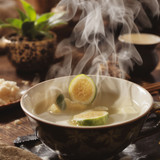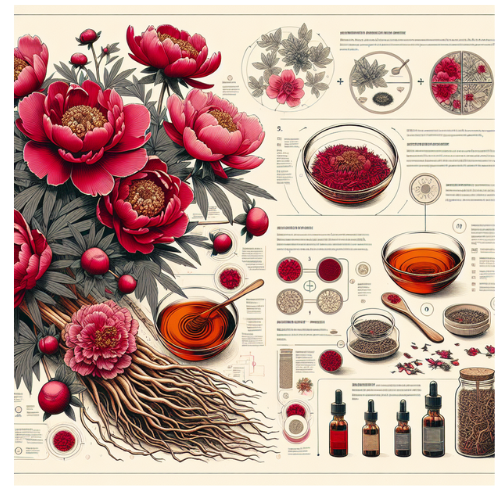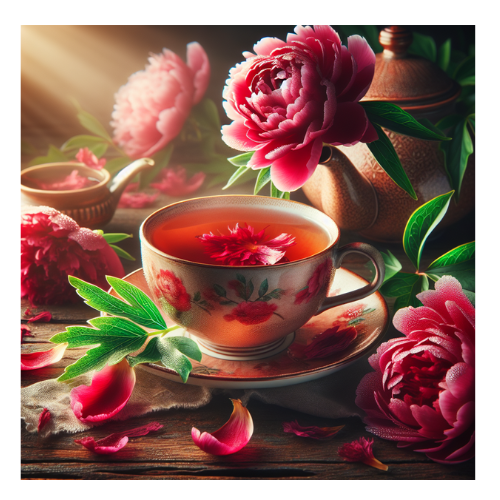

Starwest Botanicals
Organic White Tea Bags
White Tea Bags vs. Green Tea: Why They’re Different White tea and green tea come from the same plant—Camellia sinensis—but they’re made differently. That difference in processing is why white tea...
Red Peony Root, scientifically known as Paeonia lactiflora, is a treasured herb that boasts striking beauty along with remarkable medicinal properties. Esteemed in Traditional Chinese Medicine (TCM) for centuries, this potent root is celebrated for its ability to nourish blood, regulate menstrual cycles, and alleviate pain associated with menstrual discomfort. Rich in bioactive compounds, Red Peony Root serves as a holistic approach to health, providing both physical and emotional support. As interest in natural remedies continues to grow, Red Peony Root emerges as a powerful ally for those seeking balance and vitality in their lives. Discover the multifaceted benefits of this ancient herb and explore how it can enhance your modern wellness journey.
 Historical and Cultural Significance
Historical and Cultural SignificanceRed Peony Root has a deep cultural history, particularly in Eastern herbal practices. In TCM, it is traditionally used to treat imbalances in the body, particularly those related to blood health and women's reproductive issues. Its use dates back over a thousand years, finding a prominent place in historical texts aimed at promoting overall health and harmony.
In Western herbalism, Red Peony Root is gaining recognition as a valuable herbal remedy. It's often incorporated into formulas for menstrual support, and its gentle nature makes it appealing for those looking for alternatives to pharmaceutical options. The harmonious blend of its historical significance and modern applications highlights its versatility and enduring value.
Red Peony Root offers a multitude of health benefits, including:
| Benefit | Mechanism | Evidence |
|---|---|---|
| Menstrual pain relief | Spasmolytic effects via paeoniflorin | Animal + clinical formula studies PMC+15PMC+15ScienceDirect+15 |
| Anti-inflammatory | Inhibits PGE2, NO, LTB4 | TGP studies PubMedPubMed |
| Mood/PMS support | Regulates ERβ & serotonin | Rat models PMC |
| Metabolic health | Supports lipid/glucose balance | CV studies PMC |
 Preparation Methods and Dosage Recommendations
Preparation Methods and Dosage Recommendations1. Red Peony Root Tea
- Ingredients:
- 1-2 teaspoons of dried Red Peony Root
- 1 cup of boiling water
Instructions:
Dosage: Consume 1-2 cups daily, particularly useful during menstruation.
2. Red Peony Root Tincture
- Ingredients:
- Dried Red Peony Root
- High-proof alcohol (e.g., vodka)
Instructions:
Dosage: Take 1-2 droppers (approximately 30-60 drops) as needed, particularly for menstrual support.
| Herb | TCM Function | Best For | Why Use With/Instead of Red Peony Root | TCM Category |
|---|---|---|---|---|
| Chi Shao (Red Peony Root) | Clears heat, cools blood, moves blood | Menstrual cramps, inflammation, pain | Stronger cooling + blood-moving than Bai Shao | Invigorate Blood |
| Bai Shao (White Peony Root) | Nourishes blood, preserves Yin, calms Liver | PMS, muscle spasms, irritability | More nourishing and gentle; often used with Chi Shao in balance | Tonify Blood |
| Dan Shen (Salvia Root) | Moves blood, clears heart heat, calms spirit | Chest pain, insomnia, irritability | Stronger cardiovascular and calming effects | Invigorate Blood |
| Chuan Xiong (Ligusticum Root) | Invigorates blood, moves Qi, dispels wind | Headaches, irregular menstruation | Stronger on Qi + blood movement; warming | Invigorate Blood |
| Dang Gui (Angelica sinensis) | Tonifies and moves blood | Menstrual disorders, anemia, fatigue | More tonifying than Chi Shao; often used together in women’s formulas | Tonify Blood |
| Yan Hu Suo (Corydalis) | Moves Qi and blood, stops pain | Pain syndromes (any type) | Stronger analgesic effect; best for pain-focused formulas | Invigorate Blood |
| Hong Hua (Safflower) | Moves blood, unblocks menstruation | Menstrual clots, trauma, circulation | Used more for traumatic injury or stagnation | Invigorate Blood |
| Mu Dan Pi (Moutan Cortex) | Clears heat, cools blood, moves blood | Inflammatory skin conditions, bleeding | Stronger cooling + blood-clearing; often paired with Chi Shao | Clear Heat / Invigorate Blood |
You need both blood cooling and movement
You have menstrual cramps + inflammation
You want a more cleansing blood herb vs. nourishing
"I’ve used Red Peony Root tea for my cramps, and within two cycles, my pain went from unbearable to manageable. It's been a game-changer!"
— Laura M., Portland, OR
"After giving birth, I felt emotionally and physically drained. A TCM practitioner suggested Red Peony tincture—and it really helped me regain my balance."
— Mei H., Seattle, WA
Pregnancy or breastfeeding (without expert supervision)
If allergic to peony or its botanical relatives
While taking anticoagulants or antiplatelet medications
If you experience severe digestive reactions
Red Peony Root is not only a beautiful addition to your garden but also a powerful herb rich in historical significance and modern therapeutic applications. By understanding its benefits, preparation methods, and precautions, you can confidently incorporate this remarkable root into your wellness regimen. As always, consult with a healthcare professional before beginning any new herbal supplement, especially if you have existing health conditions or concerns.
Paeoniflorin—the main active compound in Red Peony Root—has been shown to relieve pain and reduce inflammation through multiple mechanisms, including modulation of adenosine A1 receptors and suppression of inflammatory pathways PMC+6Frontiers+6PMC+6Wikipedia+15PMC+15SpringerLink+15.
Radix paeoniae extracts promote endothelium-dependent vasodilation, improving blood flow and antioxidant enzyme activity in animal models PubMed+1PubMed+1. This supports its traditional role in blood nourishment and circulation.
Studies show paeoniflorin exhibits neuroprotective effects—reducing neuroinflammation, inhibiting apoptotic pathways, and regulating neurotransmitter pathways—in models of neurodegenerative disorders PMCPMC. Additionally, it modulates immune response both in vitro and in vivo PMC+15Frontiers+15ScienceDirect+15.
Animal and cell culture research indicates paeoniflorin improves glucose and lipid metabolism, mitigates oxidative stress, and supports heart function, suggesting possible benefits in cardiovascular health PMC+15PMC+15Frontiers+15.
Zhang, J. et al. "The Pharmacological Effects of Paeonia lactiflora." PubMed Central
Li, H. et al. "Paeoniflorin for Pain Relief: A Systematic Review." PubMed Central